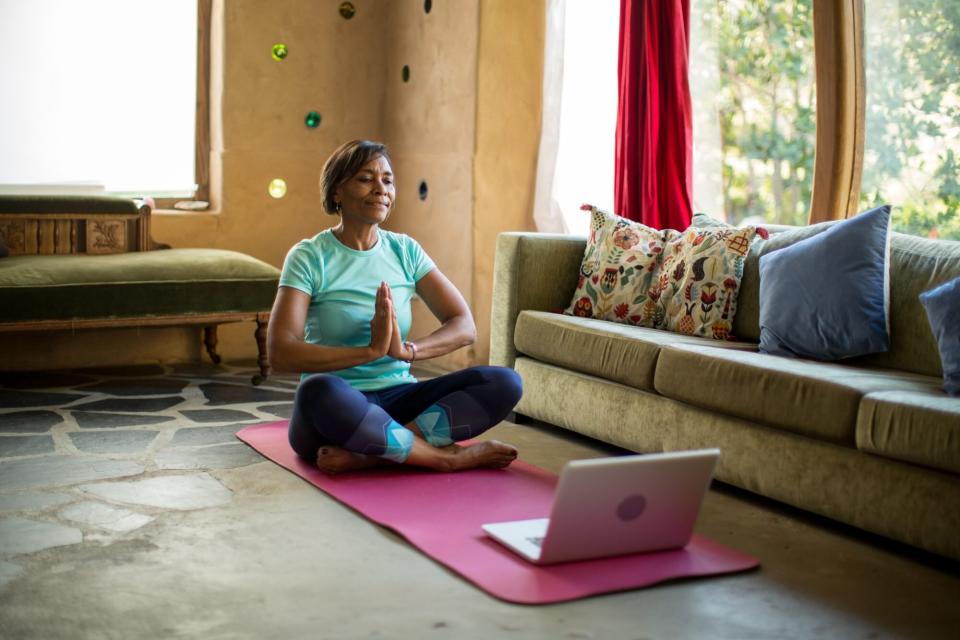Six Morning Meditations to Start Your Day Off Right
Practicing meditation has been known to relieve stress and lessen anxiety, which is why starting your day off with a morning meditation can help set your day up for success. "You're setting the tone for your day, allowing any residual tensions, anger, or unwanted feelings or thoughts lingering from your past day or sleep to dissolve," says CorePower Yoga master trainer, Emily Schmookler. "It gives you just a few moments to yourself to boost the sensation of centered calm, and [can help make you] able to handle challenge in your day with a sense of ease."
If the typical form of meditation-a straightforward focus on the breath and clearing of the mind-doesn't fit your needs, there are so many different types to choose from. Even focused journaling can be considered a meditative practice.
Related: Four Popular Types of Meditation, Explained
Breathing Meditation
Perhaps one of the most well-known forms of meditation is a simple breathing meditation. "This meditation requires your focus to just observe your breathing," explains Schmookler. "You'll want to start seated with a long spine (avoid collapsing in a chair)." She also says to close your eyes, or gaze down softly, and begin by taking a few deep breaths to settle into your seat, and then return to a natural rhythm of breath. From there, you'll want to start to bring awareness to your breath. "If you have an excessive amount of thoughts or feel anxious, start to draw your focus to your belly. Observe the way your belly moves," she says. "When thoughts enter, allow them to flow in and out of the mind, and bring your attention back to your belly. You'll scan the entire belly, the places that move when you breathe, even in the backside of your torso. Simply pay attention to what parts of your body move when you breathe, be almost investigatory."
Adding this practice to your morning routine can even help give you more energy. "If you find that you need more energy, you can focus more on the nose," she says. "Observe the tip of your nose, the nostrils, the temperature of air that you bring into your nose, sense the hair in your nose. You may go back and forth between the nose and the torso." To really reap the benefits, she recommends practicing this method until you feel calm and settled or set a timer anywhere from five to 20 minutes.

Alistair Berg / Getty Images
Walking Meditation
With the right mindset, your morning walk can become meditation. "Enjoy three to five minutes of physical activity and feel your body as you move," says Nkechi Deanna Njaka, Msc, neuroscientist, the mind behind The Compass, a mindfulness meditation guide. Walking meditation is great for the morning and can help get your body moving for the day ahead. "Similar to simply going for a morning walk, pay close attention to your surroundings and the breath to perform a walking meditation. How do your feet, legs, and body feel? What are the sounds and smells along the trail? What thoughts come up during this meditation?" says Njaka.
Guided Meditation
If you have the time, Njaka recommends doing longer, guided meditations so that you have space in a community with others for when you want to deepen your practice. To make the most of guided meditation, yoga teacher, celebrity holistic health coach, author, speaker Koya Webb says to find a place where you are least likely to be disturbed. "This place can range from a spiritual meditation room with cleansing herbs and candles, where you sit on a floor pillow or bolster, to your bathroom," she says. "It can be as fancy or as simple as you need it to be."
Related: How to Implement a Morning Routine
Mantra Meditation
Peloton instructor Kristin McGee is a big fan of starting her day with a mantra (a word or phrase in your mind to help you stay focused) meditation. "I love setting an intention for my day with a mantra and/or a positive affirmation. 'I am love,' 'I am calm, cared for, and connected,' 'I will lead with gratitude,' 'I choose to be present,' 'I can slay the day,' 'Inhale, Exhale' to name a few examples. Your mantra can center on whatever you want to focus on for the day," she says.
Metta Meditation
Schmookler also recommends a visualization meditation for the morning. "First begin with a long tall spine, with three points of contact on the ground (or two if in a chair)," she says. "Close your eyes or softly gaze down. Visualize an image of yourself or the essence of your own being, repeat to that image: 'May I be happy and content, May I be free from suffering, May I be at peace-visualize these words pouring into this image of self.'" She says to repeat this until you feel, "loving-kindness towards self."
Then, change the visualization into someone you love and who supports you, then a mentor, then to a stranger, to someone who challenges you, to a community you belong to (including self), and finally, to the whole world. "You change the phrase from 'May I'- to 'May You' or towards the end 'May We,'" she says. "You can change what [you're] asking for, peace, serenity, freedom, joy, love, etc."
Meditative Journaling
Using writing as a practice can be a great way to process your thoughts and keep track of your progress as you develop your morning meditation practice. "When you wake up in the morning, write down three things that you are grateful for," says Njaka.
"Journal how you feel," Webb adds. "That may help you to be consistent as well, but if you fall off track just jump right back on track, pat yourself on the back for getting started again, and take it one day at a time, one breath at a time. Before you know it you will have established a consistent meditation practice."

